During my vegan yogurt experiments, I read a lot about making coconut, almond, and rice milks at home and sorted out my own preferred methods. (Key ingredient across the board? A nylon straining bag.) Now, whenever I find myself standing in front of those Tetra Pak boxed beverages at the grocery, I consider for a second if it’s worth it for me to DIY it at home; even in the chaos of an average week, it usually is.
The one experiment I’ve avoided is soy milk. Basically, I’ve come across headlines espousing the “evils of soy” just often enough to shy away from using it as one of my alternative milk ingredients. I had no nutritional research to back up this decision; rather, it was strictly a case of “Well, I haven’t read anything bad about almonds this week. Let’s just use those!”
Still, I have long been curious about making my own tofu or vegan cheese, so when I came across a bag of soybeans at the Asian market I love exploring, I decided to finally try out boiling up a batch of my own soy milk on the “all things in moderation” philosophy. (And once you start looking, I think there may be just as many articles espousing the “many benefits of soy!”…so, I can only encourage you to make your own judgment call.)
Early research on methods led me quickly to some stunning soy milk makers, an appliance I had never seen before but one that might interest high-volume producers of any type of alternative milk. In my house, a blender and an efficient hand straining method get the job done simply and quickly enough.
Similar to my experience with rice milk that didn’t taste like commercial rice milk, there were plenty of posts lamenting that DIY versions of soy milk just didn’t match what the family was used to from the store. I read a lot about how to avoid a bitter, beany-tasting soy milk (hot water when blending, cooking after straining), and picked up a tip to add a couple tablespoons of oats to the blender to make a creamer product. I didn’t remove all the skins before blending nor did I soak the beans in water fortified with baking soda, though these are also variations out there. Like many of these DIY projects, personal preferences will lead you to your own best practices.
When I first removed the lid off the blender carafe after pureeing the soaked raw beans, I worried over the smell–something about it had a character that had me flashing back to the days I spent oil panting in the ’90s. The milk will also have a raw, beany taste at this stage. (It reminded me of eating a pea or green bean seed right out of the garden.) However, after cooking, the milk will be rich and tasty. I ended up thinning it a bit to get the consistency I was after–an extra benefit to DIYing your own. When I do it again, I will take more care to source a certifiably organic, non-GMO bean.
If you’re concerned about wasting the pulp (often referred to as okara ), worry not! This byproduct has recipe applications all its own. The skin that can form on the milk when cooking (yuba) also has myriad culinary uses.
Do you make soy milk in some other fashion? Tips and tricks that you’ve picked up that will improve results? I hope you’ll share them in the comments!
Rinse soybeans, drain, and soak in a generous amount of filtered water overnight. Drain and rinse again, removing any floating loose skins. Drain well and transfer beans to blender.
Add oats and boiled water to beans and secure lid. Puree thoroughly, being cautious that lid remains tightly closed.
Strain puree through a nylon nut milk bag into a 4 qt. pot. (I also tried straining the milk through a cheese cloth-lined strainer, but this was much more difficult to manage in my experience.) Bring the milk up to a gentle simmer, skimming off any foam or skin that forms. Continue to cook, stirring regularly, for about 20 minutes. Add salt and any sweeteners or flavorings desired. Taste and adjust flavorings as needed.
Fresh soy milk can be enjoyed as a warm beverage. Otherwise, transfer it to a glass container with a lid and allow to cool. Refrigerate to store.

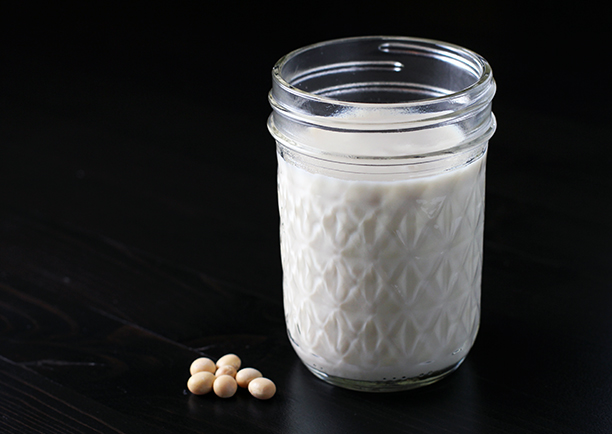

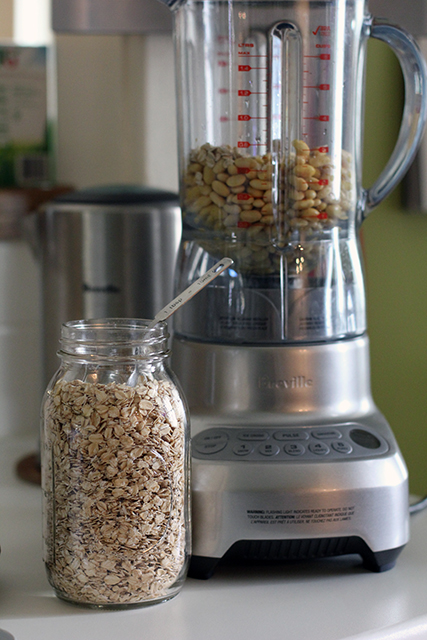



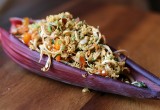




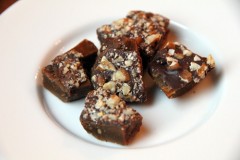
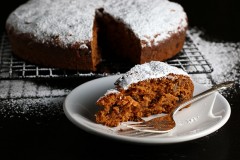


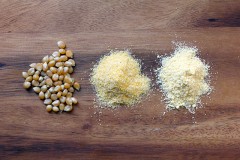

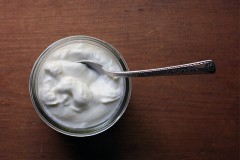




mom’s organic has the non-gmo organic soy beans.
Cool! Thanks for the Baltimore sourcing, Lan!
I think a lot of people don’t realise how simple and tasty it is to do homemade non-dairy milks at home! I’ve never tried it with soy, but I’ve got the best memories from Taiwan where breakfast isn’t complete without thick and creamy soymilk made fresh in every street stall. Yours looks wonderful, thanks for sharing!
Sounds like an awesome taste memory, Irina. Thanks for sharing!
[…] Homemade soy milk. Sounds pretty darn accessible. […]
So glad to see you embarking on DIY soy milk. One tip for you is to steam the beans. Instead of cooking and stirring the blended milk (an arduous task), steam the soaked beans, then blend the beans with suggested amount of water. Voila!
Ooh, thanks for the insight! How long do you recommend steaming them?
I found that more Okara goes into the milk when I steam the beans rather than filtering them raw. Makes for some very thick milk. I can also “feel” the okara in the milk. I am going to stick with filtering them raw, then cooking the milk. I am experimenting today on steaming the beans, not filtering them, and making tofu with the okara in tact.
Around 30 min for the amount of beans used in your recipe.
Thank you for the recipe, and so much detail!! I was wondering about how long can the milk last in the fridge? Also do you have to use glass containers or is plastic ok? Thanks!!
Hi Shawna. I did find that all my DIY non-dairy “milks” had a shorter life than store-bought and would seem to go “off” after four or five days or so. I like storing in glass, but I don’t see any problem with using plastic in this case.
Have any of you made DIY soy milk which froths?
I have a new soy milk maker- does all the manual steps outlined above.Great tasting milk (i remove the hulls of the soaked beans by rubbing the beans, add a dash of sea salt , a spoonful of raw honey and dash of Vanilla.. Get soymilk tasting as good as store-bought.
But it does not froth well :( so I my cappuccinos are not as good as I would like.
I have an answer to make your soy milk foam up! Add some xanthan gum, enough to turn it into a heavy cream or liquid coffee creamer consistency. Xanthan gum is vegan, but you may have a reaction to it if you’re allergic to corn, so be careful. It is used as a stabilizer and foaming agent. On top of that, the milk you add it to will be thicker, making your milk seem richer than it actually is, so you’ll likely want to use less of it. If you add enough to make it as thick as a custard-style ice cream base, you can put it into your ice cream maker and turn it into completely vegan ice cream.
Thanks for the tips, Elaine!
I’ve seen a ton of recipes for soy milk but it will be my first time doing it so i don’t wanna screw up…
My question is, can i make tofu with this? Since the final product will be cooked and others recipes i’ve read didn’t say anything about cooking the beans i don’t know if will haave any effect or not when adding the coagulant??
This I don’t know, though my original intent was to make tofu, too–I just still haven’t gotten that far. I think it should be fine. Anyone?
you need to cook the beans in any application. I have a soy milk maker that cooks the beans first then grinds them etc.. then after straining you then can make your tofu. So the answer is YES you still need to cook the beans even for making tofu.
Any blender recommendations? Can’t wait to try this! I just discovered some store bought soy milk uses soy bean isolate powder (yes I’m a bit late on that one!)… so not healthy :S
I have Breville Hemisphere that I like quite a bit, but aside from the blender I bought in college for $20, it’s my only experience with the appliance so take it for what it’s worth. :)
Read a dozen articles on DIY soymilk. 1st try today must have done it right. Instead of cooking the milk I simmered the beans for 15 mins, using 2 small sauce pans, so I might avoid too much frothing. Soaked them for 16 hrs. The talk of excess frothing only occured for 2-3 mins at the start of the boil. Once the initial frothing was over, and skimmed off, there was no more. Am fortunate enough to have gotten a Vitamix 18 yrs ago when prices were lower. It has the variable speeds. I am a believer that the whole beans, if they could be liquified would provide better nutrition-so I took the chance and tried to do that. Since I had read about some of the problems people had encountered with the Vitamix, I decided on using the hot water and only 1/4 of the beans to start with. 1 minute on variable and one minute on high made a 100% smooth and non-grainy milk. It was initially salty, so added more water. It was the same consistency as cows milk-and got 1-1/2 GALLONS. I did NOT notice any nutty flavor, and using the whole bean gave more volume. I will admit to doing an unhealthy thing with it in that I really do not like soy milk without Hersheys chocolate sauce. (SHAME ON ME) I will drink it in about 2 days. I understand that homemade does have a quote “shelf life” . I have heard of between 3-5 days. This is good in that it indicates there is still living nutrition in it. Store bought says it can last for 6 months or more not even refrigerated, in those paper cartons. My thinking on that is that is probably nothing of any comparitive food value is left, compared to fresh. The beans cost 50 cents, and perhaps 30 cents worth of electricity. IT IS TRULY DELICIOUS.
I’ve been making a whole bean soymilk, and it’s very easy. After soaking about 2/3 of a cup of the beans (either overnight, or an hour after bringing them to a boil) I boil them for 20-30 minutes, then process them for 2 minutes in my blender with 4 cups of water, about 1/2 teaspoon of salt, a tablespoon or so of sweetener (sugar, maple syrup, agave or honey) and a squirt of vanilla extract. I used to filter it (now THAT is work) but lately haven’t been. I have a pretty powerful blender (Vitamix), and don’t know if an ordinary blender would work. Yes, the okara is edible, which is why I decided to stop filtering. The result is a bit thicker and creamier… nothing like what you buy in the grocery store. I wish I could find organic beans for $0.89 a pound! Where? But even at $3.69 for two pounds, this saves me a lot of money. My recipe makes about a quart and a half, but you could make it thinner or thicker by adding more or less water. Obviously this recipe could also be doubled.
Perhaps unfiltered soymilk won’t be to everyone’s taste, but it’s worth a try. Hey, if you don’t like it, you can always filter it. Keep your jars super clean and it should keep in the refrigerator for a week, although mine is gone long before then. I’ve even used it successfully to make “soygurt.”
The Vitamix site recommends steaming the beans after soaking overnight. Does anyone know if this improves the nutrition and/or taste?
Okay, I’m all new to this. I have gotten the hang of making a wonderful thick rice milk, but would like to try soy milk. Micki, you grabbed my attention with soaking after bringing to a boil.
I found with rice milk, if I used hot rice and only 1/4 of the water (hot) to initially blend, then add the additional water, I end up with a thick creamy milk with nothing to filter. And that from a cheap little basic blender. Any clue if the same method might work for soybeans? I don’t mind the texture of unfiltered pieces, I just like the thick creamy versions.
Awesome! After three batches of soy milk, I have fallen in love! I going soaking the brand over night yields a much better flavor than quick soaking. So after hulling and soaking 1 cup of beans over night, I boiled them for about 10 minutes, in 7 cups of fresh water. Added two teaspoons sugar and 1/4 teaspoon salt, and let them cool about 5 minutes. Then, blended the beans with 1/2 the water they were cooked in, for two minutes, twice. Then added the remaining water, 1/4 cup millet sugar, and 1 1/2 teaspoon of vanilla. Blended another two minutes and it is wonderful. It’s wonderful without the sugar and vanilla as well. I like the thick creamy texture, so I don’t strain it. But, after letting it sit in the fridge and it settles out and the milk is easily poured off without straining.
The cold water, overnight soaking, makes for a rich, nutty flavor. The quick boil left it watery tasting.
On a side note. I added cold water to the sediment after pouring off the milk. Gave it a good shake, and let it sit. It produced more milk, just a lighter flavor.
Hi, Thank for the recipe.. I am going to give it a try. How long you can refrigerate it? Do we need to add any preservatives?
Hi. I have making soy milk here lately with BAD results. My milk has been very bitter. I’ve followed the recipes to the letter,except I used tap water instead of filtered water. Would that make a big difference? ?
I’ve never used xanthan gum, but I’m going to give it a whirl! I love froth on my chai latte or special coffees. Couldn’t figure out how to do it with my soy milk. Thanks for the tip!
Non-Beany Tasting Soymilk Recipe
I won’t list all the recipe’s I’ve tried to get non-beany tasting soymilk. NONE worked for me.
The ONLY way I have ever found to NOT get beany tasting soymilk is:
1. Boil on low – 2 cup of unsoaked soybeans for 1.5 hours to 2 hours.
2. Remove and rinse – skins on/off, doesn’t matter.
3. Put half of the cooked soybeans in blender with 5 cups water (or less if you water stronger soymilk) and blend for a few minutes.
4. Strain through a cut off and tied panty hose leg piece a few times (stretch over a bowl, tied end down). *Even the finest wire mesh is not fine enough.
5. Repeat steps 3 and 4 with the remaining cooked beans.
6. That’s it! Makes about 2 quarts.
I have made an ok tasting soy milk with dates as sweetener and vanilla. I used another recipe which was soak overnight, blend and cook but wondered if cooking the beans before blending would help with the beans taste. My main issue was it curdled when heated for my coffee and tasted awful – would salt be enough to stabilise or should I try xantham gum – I’m trying to do my own to be as low waste and simple as possible so the fewer ingredients the better. Thanks
Last night I made soy milk at home, as soon as it was done I put it in a container and put it in the fridge. Today I tried to make a latte with it, it tasted so sour. Could it be that I put it in the fridge before allowing it to cool that caused it to taste this way?